AWS module
editAWS module
editThis module periodically fetches monitoring metrics from AWS CloudWatch using GetMetricData API for AWS services.
All metrics are enabled by default.
Extra AWS charges on CloudWatch API requests will be generated by this module. Please see AWS API requests for more details.
Module-specific configuration notes
edit- AWS Credentials
The aws module requires AWS credentials configuration in order to make AWS API calls.
Users can either use AWS_ACCESS_KEY_ID, AWS_SECRET_ACCESS_KEY and/or
AWS_SESSION_TOKEN, or use shared AWS credentials file.
Please see AWS credentials options for more details.
- regions
This module also accepts optional configuration regions to specify which
AWS regions to query metrics from. If the regions parameter is not set in the
config file, then by default, the aws module will query metrics from all available
AWS regions. If endpoint is specified, regions becomes a required config parameter.
- latency
Some AWS services send monitoring metrics to CloudWatch with a latency to
process larger than Metricbeat collection period. This will cause data points missing
or none get collected by Metricbeat. In this case, please specify a latency
parameter so collection start time and end time will be shifted by the given
latency amount.
- endpoint
Most AWS services offer a regional endpoint that can be used to make requests.
The general syntax of a regional endpoint is protocol://service-code.region-code.endpoint-code.
Some services, such as IAM, do not support regions. The endpoints for these
services do not include a region. In aws module, endpoint config is to set
the endpoint-code part, such as amazonaws.com, amazonaws.com.cn, c2s.ic.gov,
sc2s.sgov.gov.
If endpoint is specified, regions config becomes required. For example:
- module: aws
period: 5m
endpoint: amazonaws.com.cn
regions: cn-north-1
metricsets:
- ec2
- fips_enabled
Enforces the use of FIPS service endpoints. See AWS credentials options for more information.
- module: aws
period: 5m
fips_enabled: true
regions:
- us-east-1
- us-east-2
- us-west-1
- us-west-2
metricsets:
- ec2
The aws module comes with a predefined dashboard. For example:
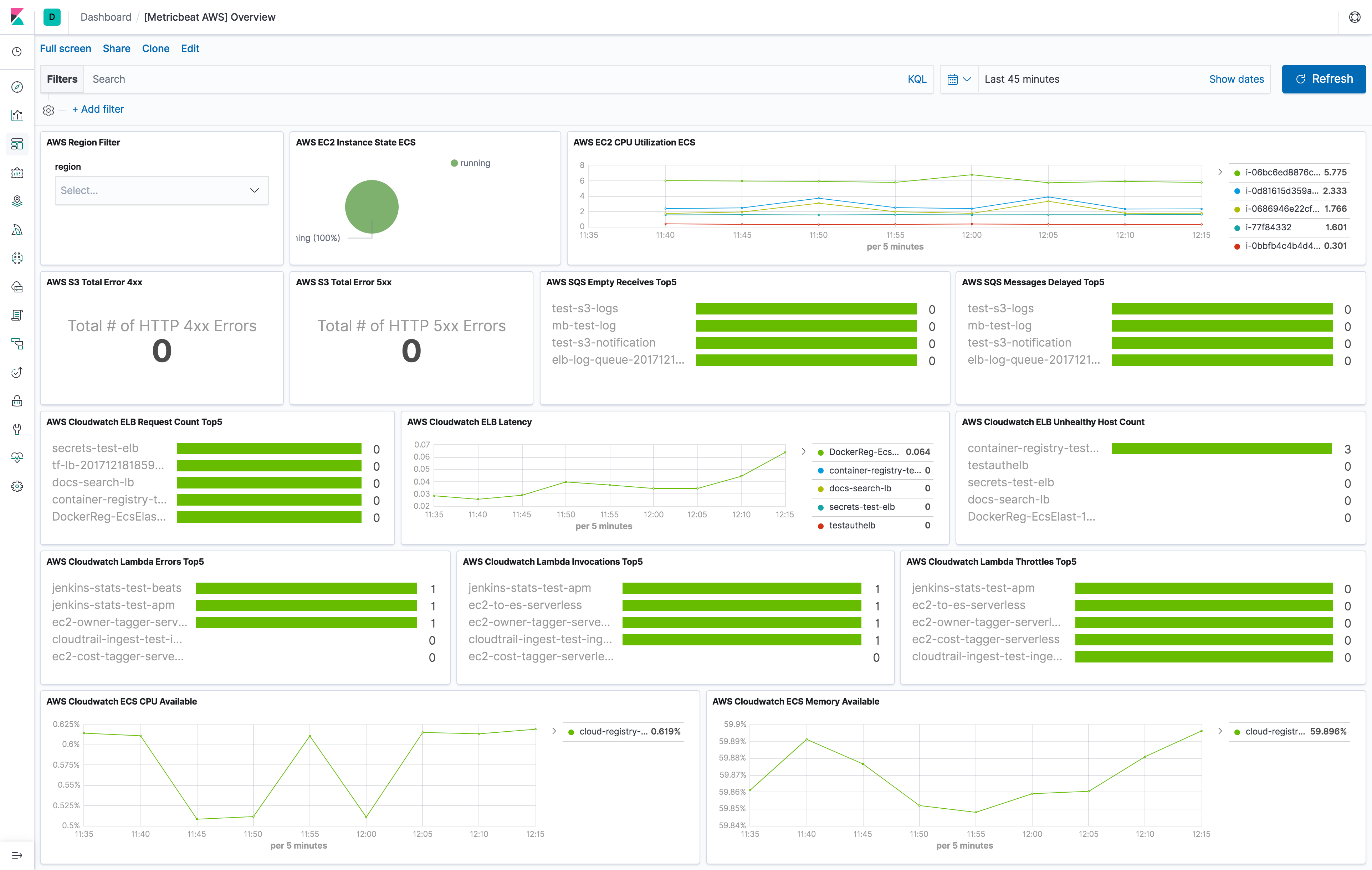
Metricsets
editCurrently, we have billing, cloudwatch, dynamodb, ebs, ec2, elb,
lambda, natgateway, rds, s3_daily_storage, s3_request, sns, sqs,
transitgateway, usage and vpn metricset in aws module.
Collecting tags for ec2, rds, cloudwatch, and metricset created based on
cloudwatch using light module is supported.
- tags.: Tag key value pairs from aws resources. A tag is a label that user assigns to an AWS resource.
billing
editBilling metric data includes the estimated charges for every service in the AWS
account and the estimated overall total charge for the AWS account. The estimated
charges are calculated and sent several times daily to CloudWatch. Therefore,
period in aws module configuration is set to 12h.
The billing metricset comes with a predefined dashboard:
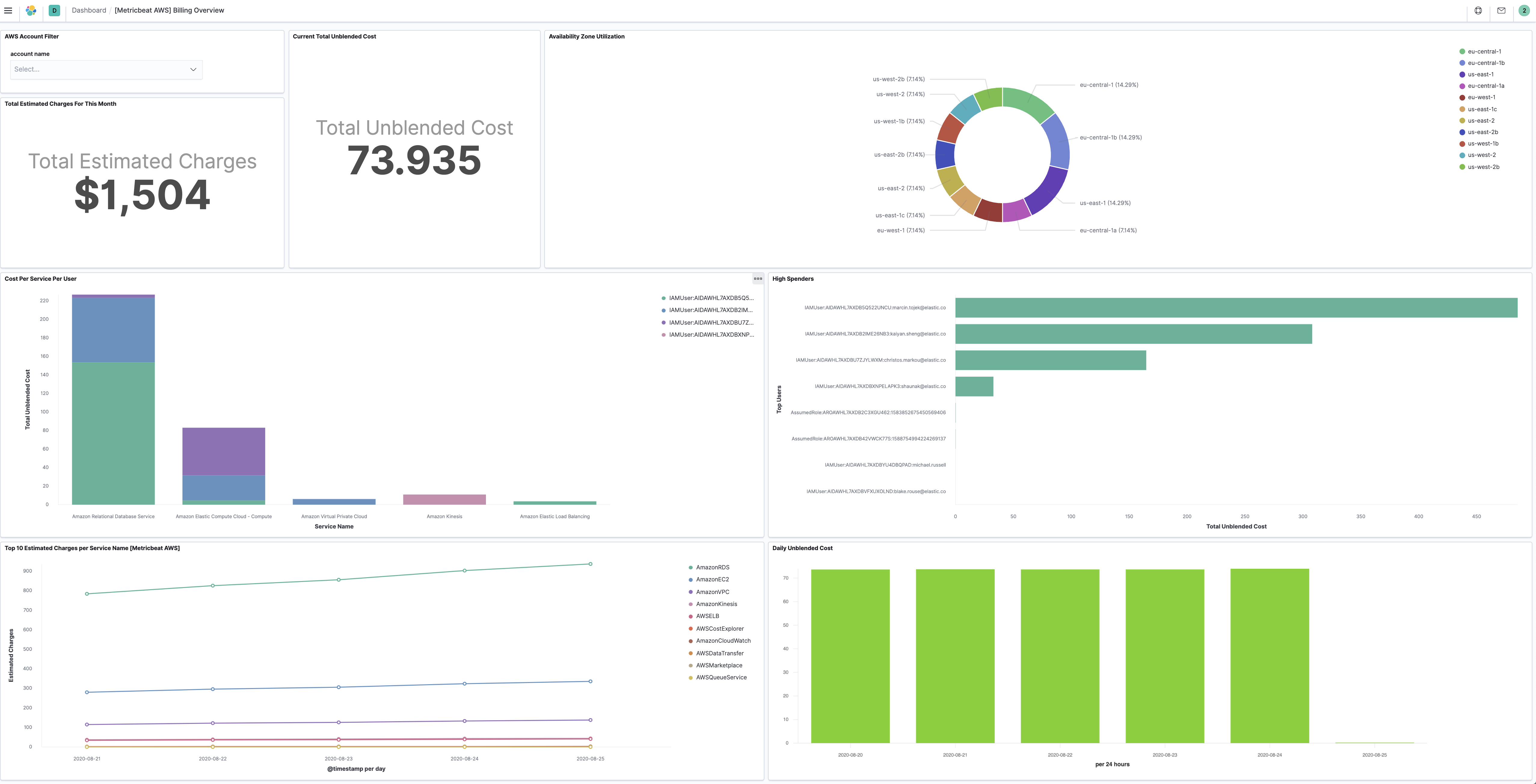
cloudwatch
editThis metricset allows users to query metrics from AWS CloudWatch with any given namespaces or specific instance with a given period. Please see AWS Services That Publish CloudWatch Metrics for a list of AWS services that publish metrics to CloudWatch.
dynamodb
editDynamoDB sends metrics to CloudWatch periodically for better monitoring how web application or service is performing.
The dynamodb metricset comes with a predefined dashboard:
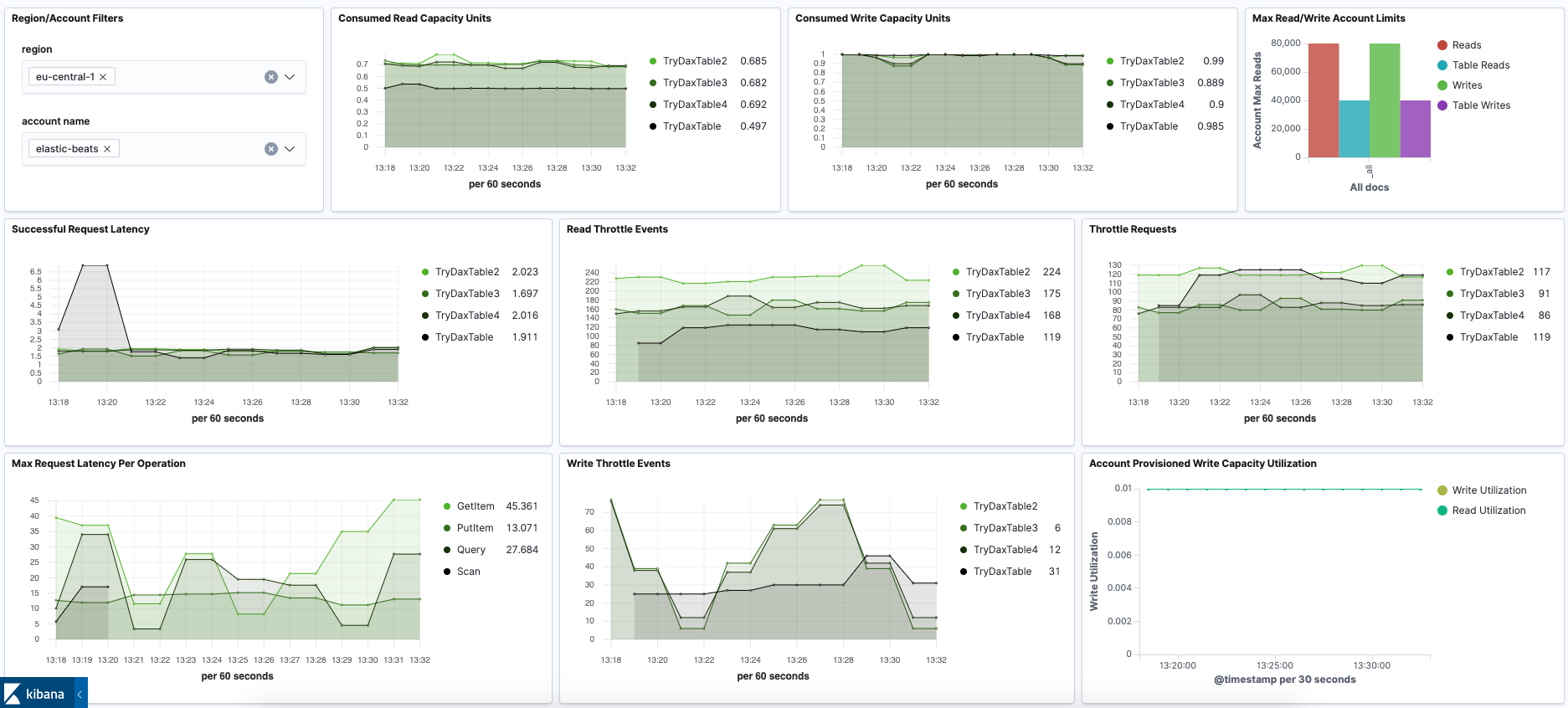
ebs
editFor basic monitoring in AWS EBS volumes, data is available automatically in
5-minute periods at no charge. This includes data for the root device volumes
for EBS-backed instances. User can also enable detailed monitoring for
provisioned IOPS SSD (io1) volumes to automatically send one-minute metrics to
CloudWatch. Default period in aws module configuration is set to 5m for ebs
metricset.
The ebs metricset comes with a predefined dashboard:
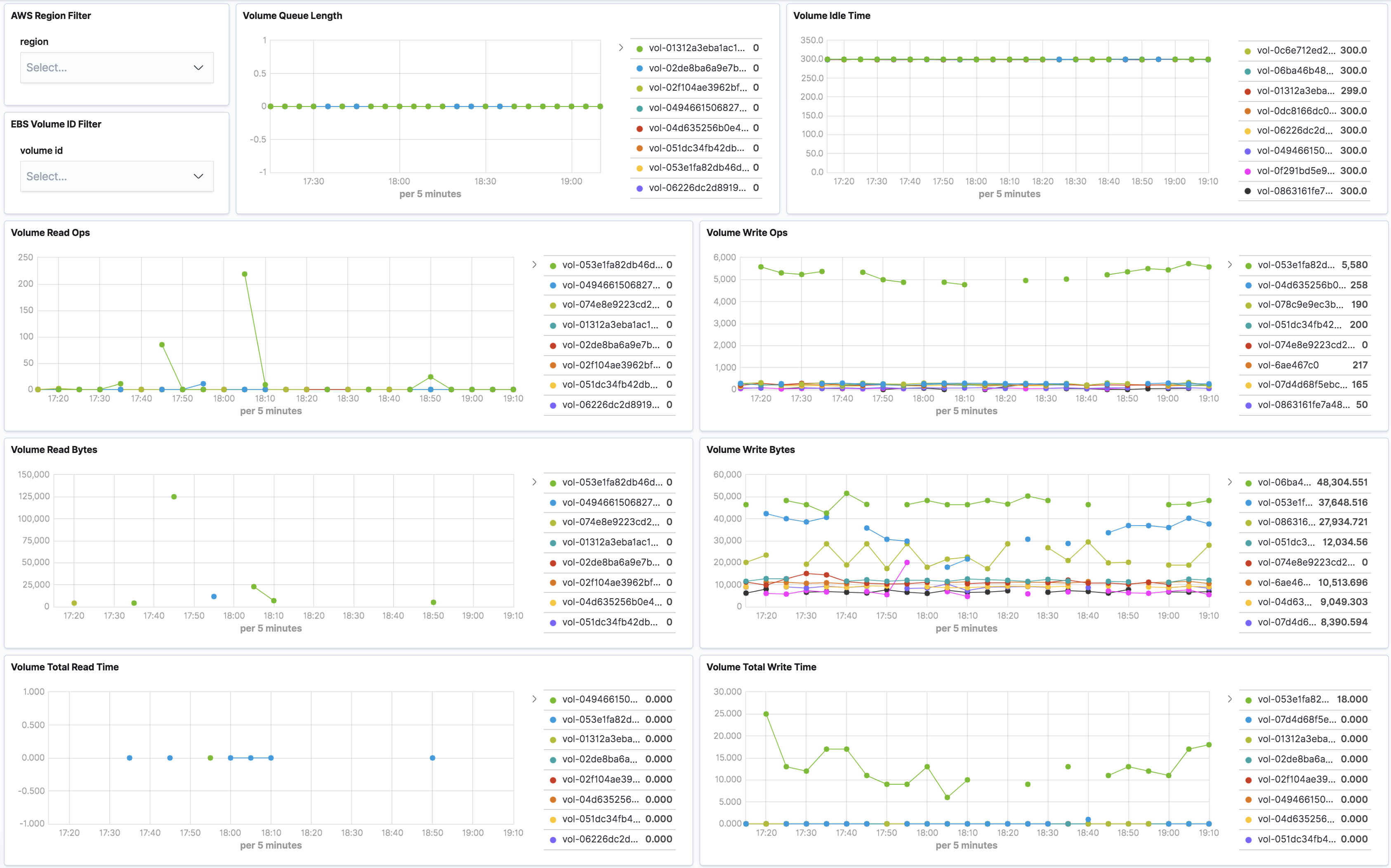
ec2
editBy default, Amazon EC2 sends metric data to CloudWatch every 5 minutes. With this basic monitoring, period in aws module
configuration should be larger or equal than 300s. If period is set to be less than 300s, the same cloudwatch metrics
will be collected more than once which will cause extra fees without getting more granular metrics. For example, in US East (N. Virginia) region, it costs
$0.01/1000 metrics requested using GetMetricData. Please see AWS CloudWatch Pricing
for more details. To avoid unnecessary charges, period is preferred to be set to 300s or multiples of 300s, such as
600s and 900s. For more granular monitoring data you can enable detailed monitoring on the instance to get metrics every 1 minute. Please see
Enabling Detailed Monitoring for instructions
on how to enable detailed monitoring. With detailed monitoring enabled, period in aws module configuration can be any number
larger than 60s. Since AWS sends metric data to CloudWatch in 1-minute periods, setting metricbeat module period less
than 60s will cause extra API requests which means extra charges on AWS. To avoid unnecessary charges, period is
preferred to be set to 60s or multiples of 60s, such as 120s and 180s.
The ec2 metricset comes with a predefined dashboard:
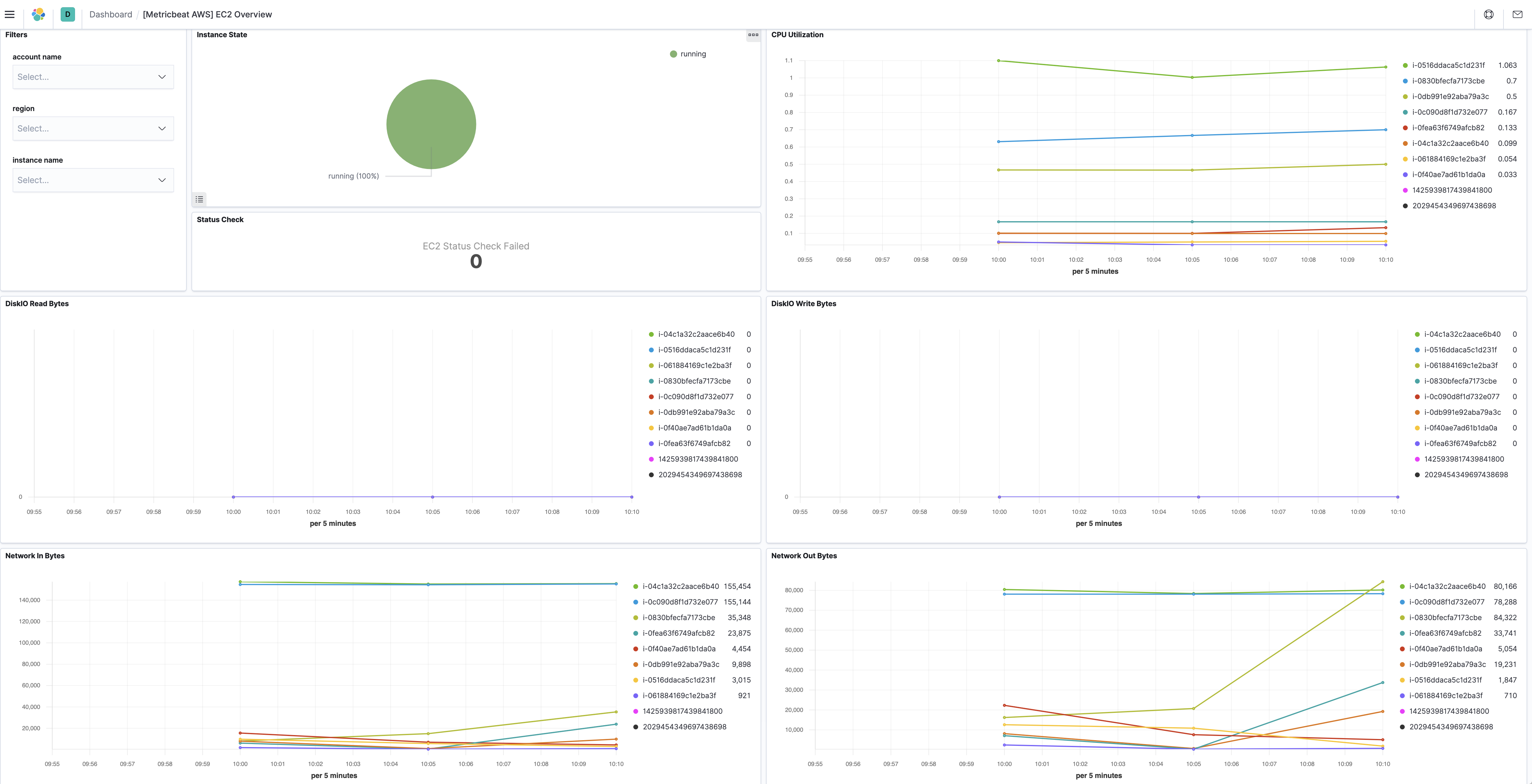
elb
editelb metricset collects CloudWatch metrics from classic load balancer, application load balancer and network load balancer.
All three kinds of elastic load balancing reports metrics to Cloudwatch only when requests are flowing
through the load balancer. If there are requests flowing through the load balancer,
Elastic Load Balancing measures and sends its metrics in 60-second intervals.
If there are no requests flowing through the load balancer or no data for a metric,
the metric is not reported.
Therefore, period in aws module configuration is set to 1m.
The elb metricset comes with a predefined dashboard:
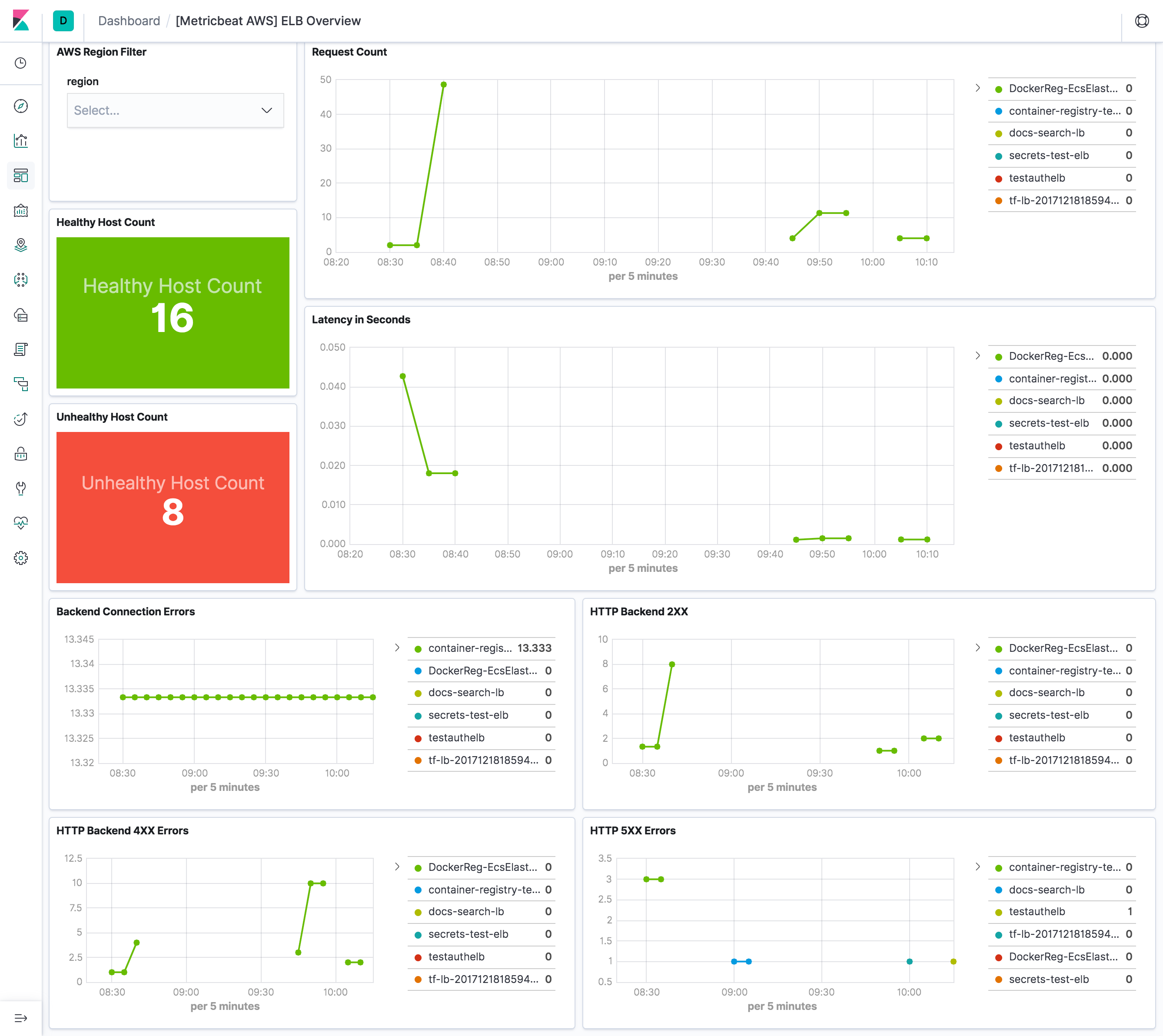
lambda
editWhen an invocation completes, Lambda sends a set of metrics to CloudWatch for that invocation.
Default period in aws module configuration is set to 5m for lambda metricset.
The lambda metricset comes with a predefined dashboard:
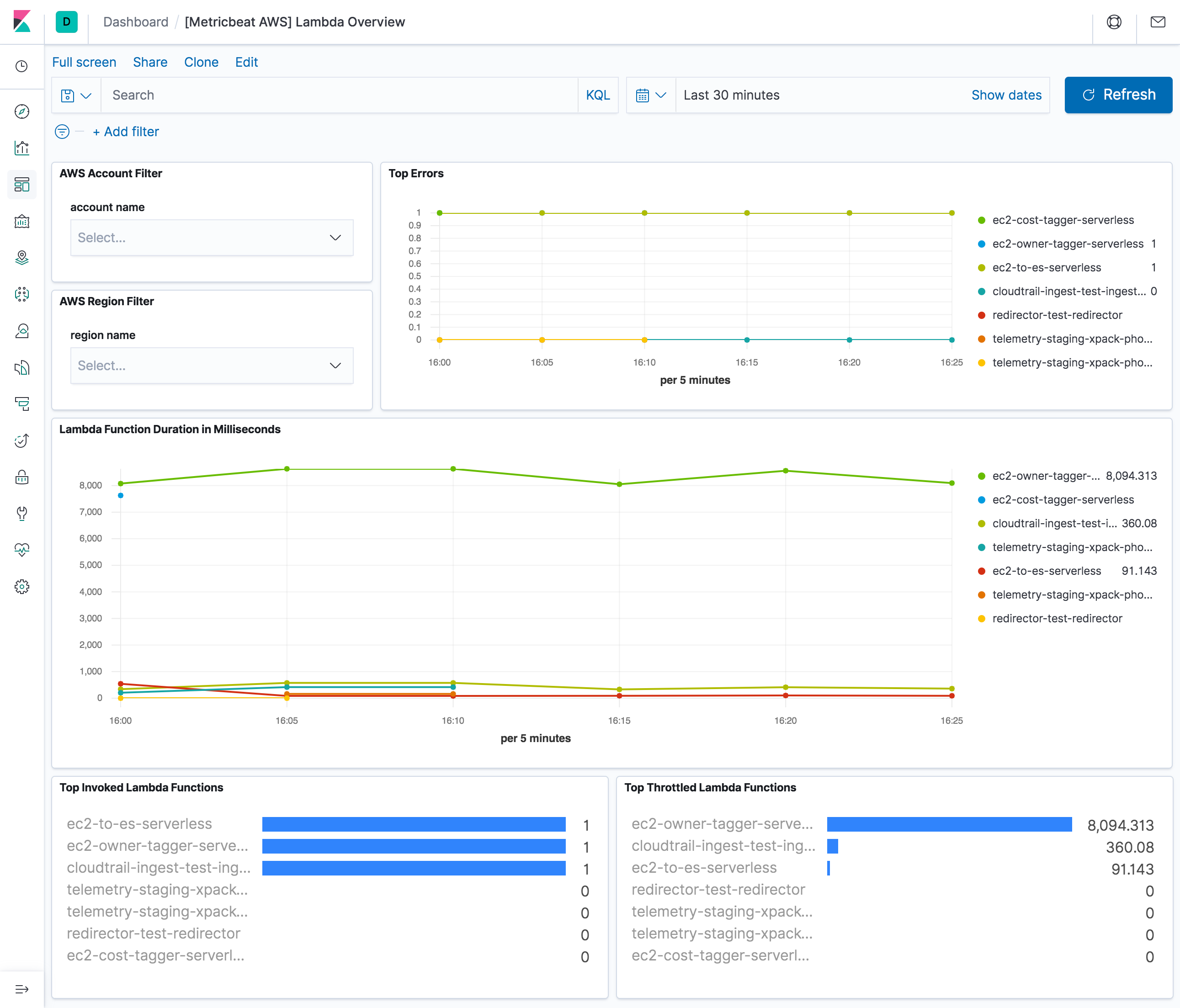
natgateway
editCloudWatch collects information from NAT gateways and creates readable, near real-time metrics.
This metricset enables users to collect these metrics from CloudWatch to monitor and troubleshoot
their NAT gateway. NAT gateway metric data is provided at 1-minute intervals and therefore,
period for natgateway metricset is recommended to be 1m or multiples of 1m.
rds
editperiod for rds metricset is recommended to be 60s or multiples of 60s because Amazon RDS sends metrics and
dimensions to Amazon CloudWatch every minute.
The rds metricset comes with a predefined dashboard:
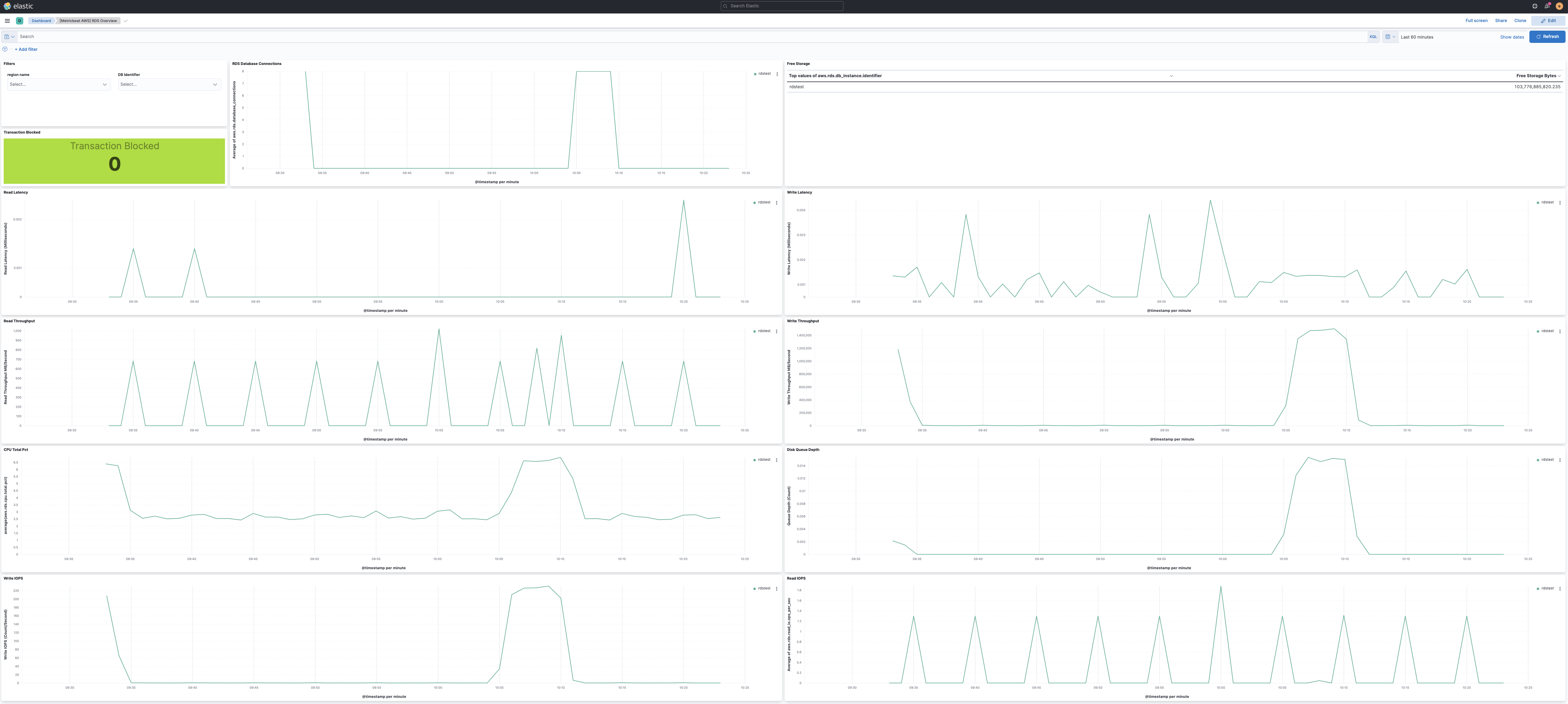
s3_daily_storage
editDaily storage metrics for S3 buckets are reported once per day with no additional cost. Since they are daily metrics,
period for s3_daily_storage metricset is recommended to be 86400s or multiples of 86400s.
s3_request
editRequest metrics are available
at 1-minute intervals with additional charges. The s3_request metricset will give more
granular data to track S3 bucket usage. The period for s3_request metricset can be set to 60s or multiples of 60s.
But because of the extra charges for querying these metrics, the period is recommended to set to 86400s. The user can
always adjust this to the granularity they want. Request metrics are not enabled by default for S3 buckets. Please see
How to
Configure Request Metrics for S3 for instructions on how to enable request metrics for
each S3 bucket.
The s3_daily_storage and s3_request metricset comes with a predefined combined dashboard:
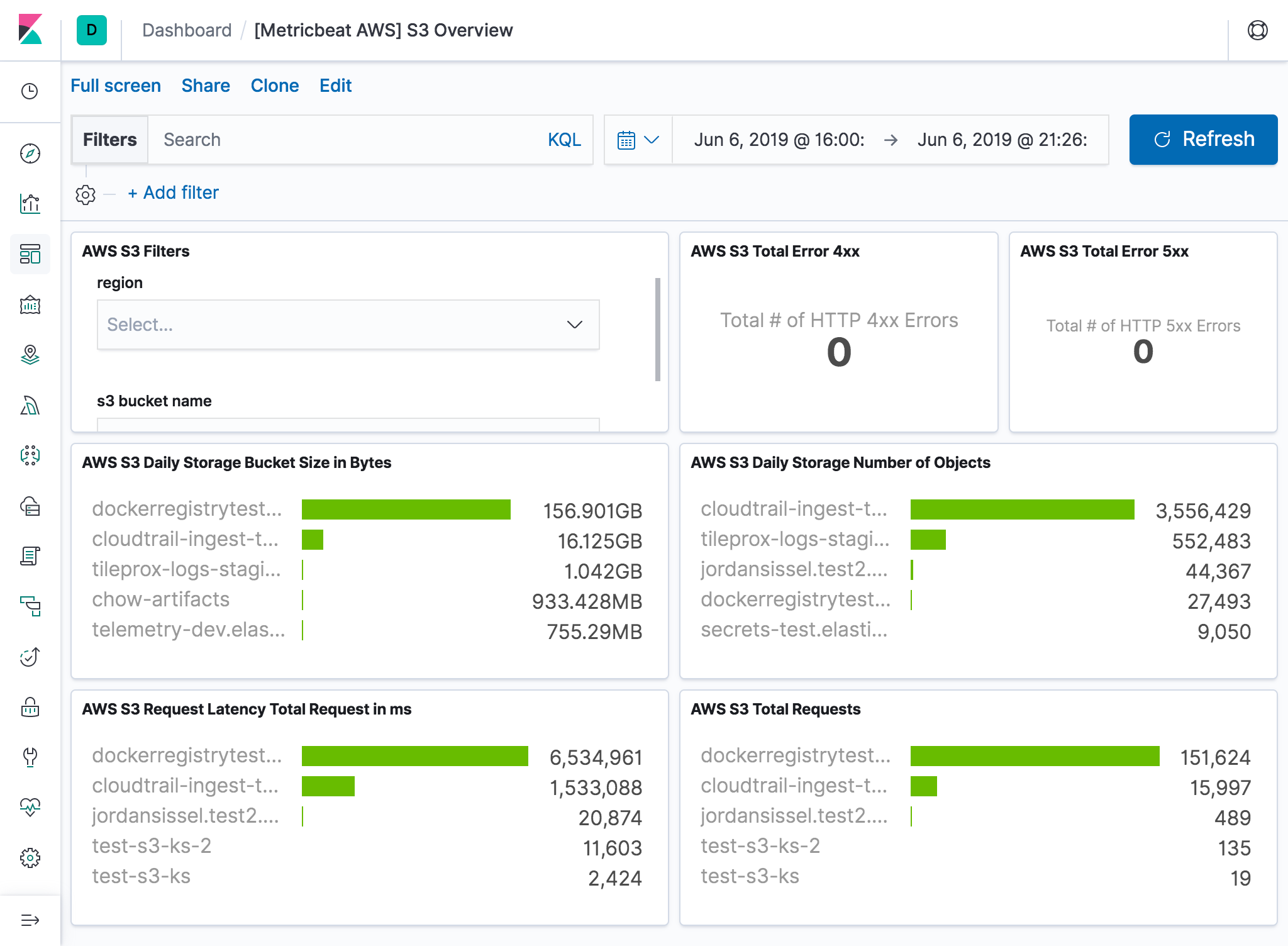
sqs
editCloudWatch metrics for Amazon SQS queues are automatically collected and pushed to CloudWatch every 5 minutes,
the period for sqs metricset is recommended to be 300s or multiples of 300s.
The sqs metricset comes with a predefined dashboard:
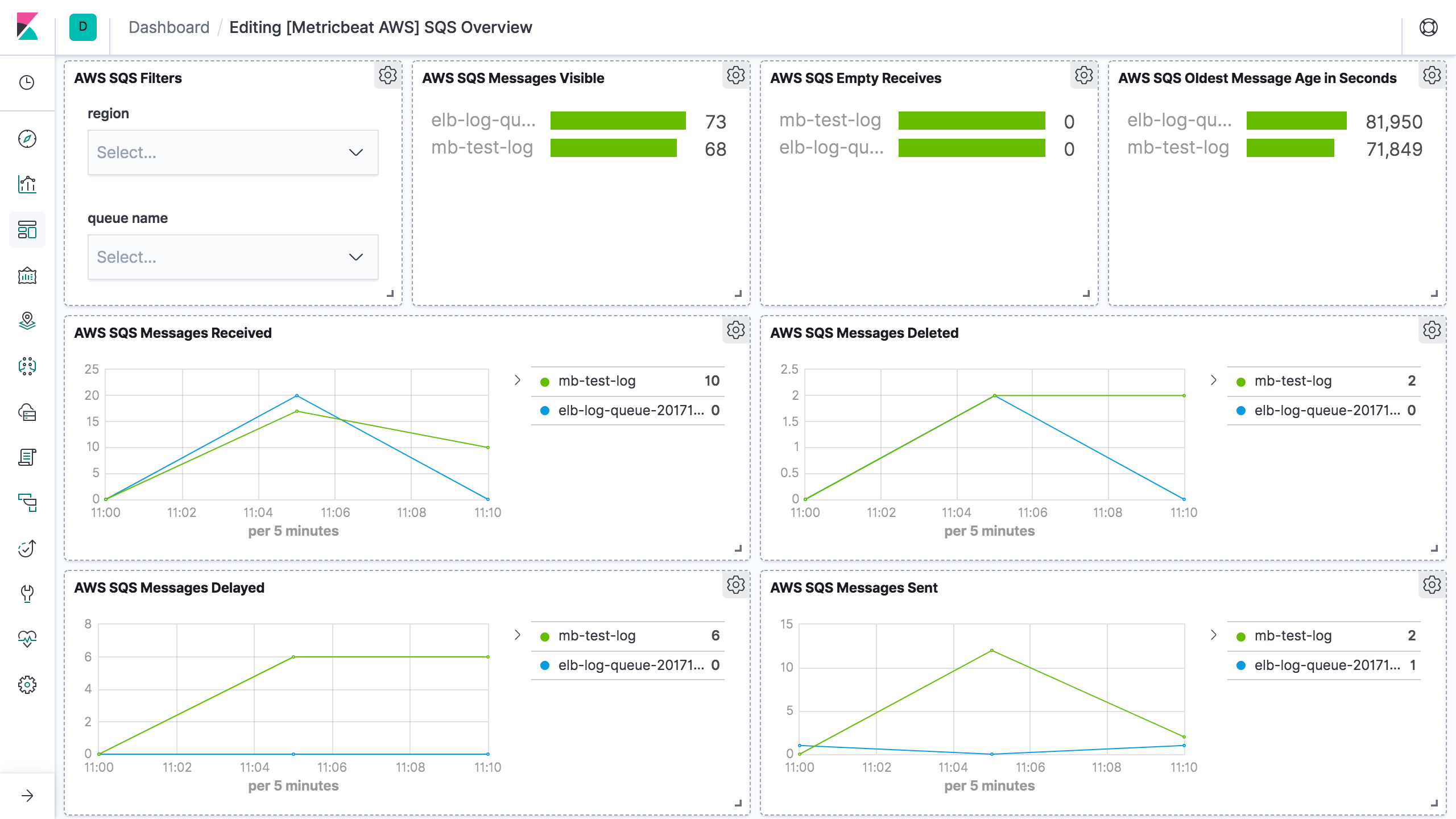
transitgateway
editAmazon VPC reports metrics to CloudWatch only when requests are flowing through
the transit gateway. If there are requests flowing through the transit gateway,
Amazon VPC measures and sends its metrics in 60-second intervals. period for
transitgateway metricset is recommended to be 1m or multiples of 1m.
usage
editCloudWatch collects metrics that track the usage of some AWS resources. These
metrics correspond to AWS service quotas. Tracking these metrics can help
proactively manage quotas. Service quota usage metrics are in the AWS/Usage
namespace and are collected every minute. Therefore, period in aws module
configuration for usage metricset is set to 1m.
The usage metricset comes with a predefined dashboard:
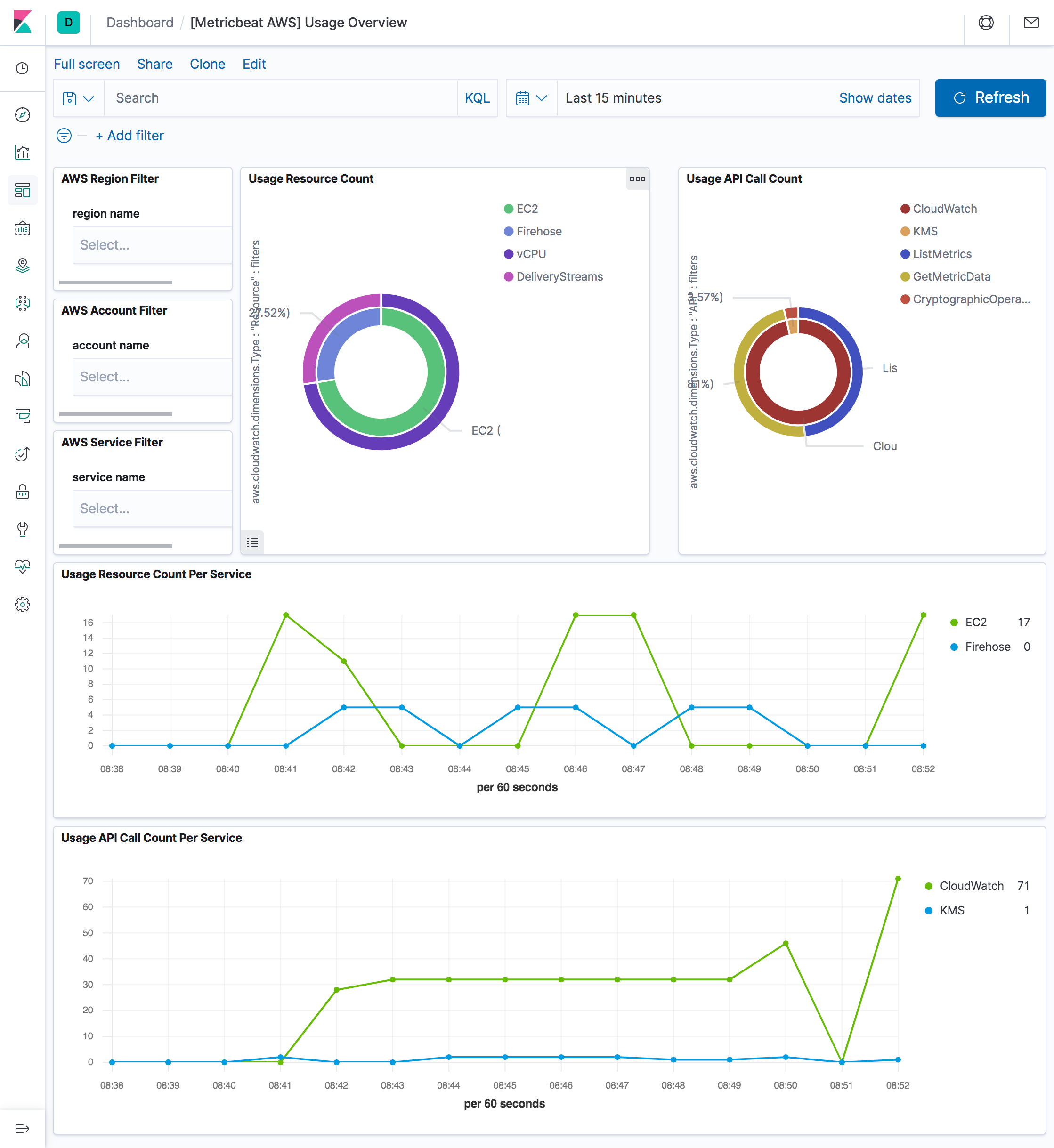
vpn
editCloudWatch collects and processes raw data from the VPN service into readable, near real-time metrics for users to better understand the performance of their web applications and services.
AWS API requests count
editThis session is to document what are the AWS API called made by each metricset
in aws module. This will be useful for users to estimate costs for using aws
module.
Note: some AWS APIs need pagination like ListMetrics and GetMetricData. Count value is depends on the number of results.
ListMetrics max page size: 500, based on AWS API ListMetrics
GetMetricData max page size: 100, based on AWS API GetMetricData
AWS API Name |
AWS API Count |
Frequency |
IAM ListAccountAliases |
1 |
Once on startup |
STS GetCallerIdentity |
1 |
Once on startup |
EC2 DescribeRegions |
1 |
Once on startup |
CloudWatch ListMetrics |
Total number of results / ListMetrics max page size |
Per region per namespace per collection period |
CloudWatch GetMetricData |
Total number of results / GetMetricData max page size |
Per region per namespace per collection period |
billing, ebs, elb, sns, usage and lambda are the same as cloudwatch metricset.
AWS Credentials Configuration
editTo configure AWS credentials, either put the credentials into the Metricbeat configuration, or use a shared credentials file, as shown in the following examples.
Configuration parameters
edit- access_key_id: first part of access key.
- secret_access_key: second part of access key.
- session_token: required when using temporary security credentials.
- credential_profile_name: profile name in shared credentials file.
- shared_credential_file: directory of the shared credentials file.
- role_arn: AWS IAM Role to assume.
-
endpoint: URL of the entry point for an AWS web service.
Most AWS services offer a regional endpoint that can be used to make requests.
The general syntax of a regional endpoint is
protocol://service-code.region-code.endpoint-code. Some services, such as IAM, do not support regions. The endpoints for these services do not include a region. Inawsmodule,endpointconfig is to set theendpoint-codepart, such asamazonaws.com,amazonaws.com.cn,c2s.ic.gov,sc2s.sgov.gov. -
proxy_url: URL of the proxy to use to connect to AWS web services. The syntax is
http(s)://<IP/Hostname>:<port> -
fips_enabled: Enabling this option changes the service names from
s3tos3-fipsfor connecting to the correct service endpoint. For example:s3-fips.us-gov-east-1.amazonaws.com. All services used by Beats are FIPS compatible except fortaggingbut only certain regions are FIPS compatible. See https://aws.amazon.com/compliance/fips/ or the appropriate service page, https://docs.aws.amazon.com/general/latest/gr/aws-service-information.html, for a full list of FIPS endpoints and regions. - ssl: This specifies SSL/TLS configuration. If the ssl section is missing, the host’s CAs are used for HTTPS connections. See SSL for more information.
- default_region: Default region to query if no other region is set.
Supported Formats
editThe examples in this section refer to Metricbeat, but the credential options for authentication with AWS are the same no matter which Beat is being used.
-
Use
access_key_id,secret_access_key, and/orsession_token
Users can either put the credentials into the Metricbeat module configuration or use
environment variable AWS_ACCESS_KEY_ID, AWS_SECRET_ACCESS_KEY and/or
AWS_SESSION_TOKEN instead.
If running on Docker, these environment variables should be added as a part of the docker command. For example, with Metricbeat:
$ docker run -e AWS_ACCESS_KEY_ID=abcd -e AWS_SECRET_ACCESS_KEY=abcd -d --name=metricbeat --user=root --volume="$(pwd)/metricbeat.aws.yml:/usr/share/metricbeat/metricbeat.yml:ro" docker.elastic.co/beats/metricbeat:7.11.1 metricbeat -e -E cloud.auth=elastic:1234 -E cloud.id=test-aws:1234
Sample metricbeat.aws.yml looks like:
metricbeat.modules:
- module: aws
period: 5m
access_key_id: ${AWS_ACCESS_KEY_ID}
secret_access_key: ${AWS_SECRET_ACCESS_KEY}
session_token: ${AWS_SESSION_TOKEN}
metricsets:
- ec2
Environment variables can also be added through a file. For example:
$ cat env.list AWS_ACCESS_KEY_ID=abcd AWS_SECRET_ACCESS_KEY=abcd $ docker run --env-file env.list -d --name=metricbeat --user=root --volume="$(pwd)/metricbeat.aws.yml:/usr/share/metricbeat/metricbeat.yml:ro" docker.elastic.co/beats/metricbeat:7.11.1 metricbeat -e -E cloud.auth=elastic:1234 -E cloud.id=test-aws:1234
-
Use
credential_profile_nameand/orshared_credential_file
If access_key_id, secret_access_key and role_arn are all not given, then
metricbeat will check for credential_profile_name. If you use different credentials for
different tools or applications, you can use profiles to configure multiple
access keys in the same configuration file. If there is no credential_profile_name
given, the default profile will be used.
shared_credential_file is optional to specify the directory of your shared
credentials file. If it’s empty, the default directory will be used.
In Windows, shared credentials file is at C:\Users\<yourUserName>\.aws\credentials.
For Linux, macOS or Unix, the file is located at ~/.aws/credentials. When running as a service,
the home path depends on the user that manages the service, so the shared_credential_file parameter can be used to avoid ambiguity. Please see
Create Shared Credentials File
for more details.
-
Use
role_arn
role_arn is used to specify which AWS IAM role to assume for generating
temporary credentials. If role_arn is given, metricbeat will check if
access keys are given. If not, metricbeat will check for credential profile
name. If neither is given, default credential profile will be used. Please make
sure credentials are given under either a credential profile or access keys.
If running on Docker, the credential file needs to be provided via a volume mount. For example, with Metricbeat:
docker run -d --name=metricbeat --user=root --volume="$(pwd)/metricbeat.aws.yml:/usr/share/metricbeat/metricbeat.yml:ro" --volume="/Users/foo/.aws/credentials:/usr/share/metricbeat/credentials:ro" docker.elastic.co/beats/metricbeat:7.11.1 metricbeat -e -E cloud.auth=elastic:1234 -E cloud.id=test-aws:1234
Sample metricbeat.aws.yml looks like:
metricbeat.modules:
- module: aws
period: 5m
credential_profile_name: elastic-beats
shared_credential_file: /usr/share/metricbeat/credentials
metricsets:
- ec2
-
Use AWS credentials in Metricbeat configuration
metricbeat.modules: - module: aws period: 300s metricsets: - ec2 access_key_id: '<access_key_id>' secret_access_key: '<secret_access_key>' session_token: '<session_token>'or
metricbeat.modules: - module: aws period: 300s metricsets: - ec2 access_key_id: '${AWS_ACCESS_KEY_ID:""}' secret_access_key: '${AWS_SECRET_ACCESS_KEY:""}' session_token: '${AWS_SESSION_TOKEN:""}' -
Use IAM role ARN
metricbeat.modules: - module: aws period: 300s metricsets: - ec2 role_arn: arn:aws:iam::123456789012:role/test-mb -
Use shared AWS credentials file
metricbeat.modules: - module: aws period: 300s metricsets: - ec2 credential_profile_name: test-mb -
Use IAM role ARN with shared AWS credentials file
metricbeat.modules: - module: aws period: 5m role_arn: arn:aws:iam::123456789012:role/test-mb shared_credential_file: /Users/mb/.aws/credentials_backup credential_profile_name: test metricsets: - ec2
AWS Credentials Types
editThere are two different types of AWS credentials can be used: access keys and temporary security credentials.
- Access keys
AWS_ACCESS_KEY_ID and AWS_SECRET_ACCESS_KEY are the two parts of access keys.
They are long-term credentials for an IAM user or the AWS account root user.
Please see
AWS Access Keys
and Secret Access Keys
for more details.
- IAM role ARN
An IAM role is an IAM identity that you can create in your account that has specific permissions that determine what the identity can and cannot do in AWS. A role does not have standard long-term credentials such as a password or access keys associated with it. Instead, when you assume a role, it provides you with temporary security credentials for your role session. IAM role Amazon Resource Name (ARN) can be used to specify which AWS IAM role to assume to generate temporary credentials. Please see AssumeRole API documentation for more details.
Here are the steps to set up IAM role using AWS CLI for Metricbeat. Please replace
123456789012 with your own account ID.
Step 1. Create example-policy.json file to include all permissions:
{
"Version": "2012-10-17",
"Statement": [
{
"Sid": "VisualEditor0",
"Effect": "Allow",
"Action": [
"s3:GetObject",
"sqs:ReceiveMessage"
],
"Resource": "*"
},
{
"Sid": "VisualEditor1",
"Effect": "Allow",
"Action": "sqs:ChangeMessageVisibility",
"Resource": "arn:aws:sqs:us-east-1:123456789012:test-fb-ks"
},
{
"Sid": "VisualEditor2",
"Effect": "Allow",
"Action": "sqs:DeleteMessage",
"Resource": "arn:aws:sqs:us-east-1:123456789012:test-fb-ks"
},
{
"Sid": "VisualEditor3",
"Effect": "Allow",
"Action": [
"sts:AssumeRole",
"sqs:ListQueues",
"tag:GetResources",
"ec2:DescribeInstances",
"cloudwatch:GetMetricData",
"ec2:DescribeRegions",
"iam:ListAccountAliases",
"sts:GetCallerIdentity",
"cloudwatch:ListMetrics"
],
"Resource": "*"
}
]
}
Step 2. Create IAM policy using the aws iam create-policy command:
$ aws iam create-policy --policy-name example-policy --policy-document file://example-policy.json
Step 3. Create the JSON file example-role-trust-policy.json that defines the trust relationship of the IAM role
{
"Version": "2012-10-17",
"Statement": {
"Effect": "Allow",
"Principal": { "AWS": "arn:aws:iam::123456789012:root" },
"Action": "sts:AssumeRole"
}
}
Step 4. Create the IAM role and attach the policy:
$ aws iam create-role --role-name example-role --assume-role-policy-document file://example-role-trust-policy.json $ aws iam attach-role-policy --role-name example-role --policy-arn "arn:aws:iam::123456789012:policy/example-policy"
After these steps are done, IAM role ARN can be used for authentication in Metricbeat
aws module.
- Temporary security credentials
Temporary security credentials has a limited lifetime and consists of an
access key ID, a secret access key, and a security token which typically returned
from GetSessionToken. MFA-enabled IAM users would need to submit an MFA code
while calling GetSessionToken. Please see
Temporary Security Credentials
for more details.
sts get-session-token AWS CLI can be used to generate temporary credentials. For example. with MFA-enabled:
aws> sts get-session-token --serial-number arn:aws:iam::1234:mfa/your-email@example.com --token-code 456789 --duration-seconds 129600
Because temporary security credentials are short term, after they expire, the user needs to generate new ones and modify the aws.yml config file with the new credentials. Unless live reloading feature is enabled for Metricbeat, the user needs to manually restart Metricbeat after updating the config file in order to continue collecting Cloudwatch metrics. This will cause data loss if the config file is not updated with new credentials before the old ones expire. For Metricbeat, we recommend users to use access keys in config file to enable aws module making AWS api calls without have to generate new temporary credentials and update the config frequently.
IAM policy is an entity that defines permissions to an object within your AWS environment. Specific permissions needs to be added into the IAM user’s policy to authorize Metricbeat to collect AWS monitoring metrics. Please see documentation under each metricset for required permissions.
Running on EKS
edit- WebIdentity authentication flow
See documentation in order to create a IAM Role for Service account: https://docs.aws.amazon.com/eks/latest/userguide/specify-service-account-role.html
Once you have create the IRSA you can annotate metricbeat service account with it
apiVersion: v1
kind: ServiceAccount
metadata:
annotations:
eks.amazonaws.com/role-arn: arn:aws:iam::<ACCOUNT_ID>:role/<IRSA_ID>
name: metricbeat
namespace: kube-system
labels:
k8s-app: metricbeat
In order to enable WebIdentity authentication flow you need to add a trust relationship to the IRSA:
{
"Effect": "Allow",
"Principal": {
"Federated": "arn:aws:iam::<ACCOUNT_ID>:oidc-provider/oidc.eks.<REGION>.amazonaws.com/id/<OIDC_PROVIDER_ID>"
},
"Action": "sts:AssumeRoleWithWebIdentity",
"Condition": {
"StringEquals": {
"oidc.eks.REGION.amazonaws.com/id/<OIDC_PROVIDER_ID>:sub": "system:serviceaccount:kube-system:metricbeat",
"oidc.eks.REGION.amazonaws.com/id/<OIDC_PROVIDER_ID>:aud": "sts.amazonaws.com"
}
}
}
In this case there’s no need to add role_arn to modules config.
Example configuration
editThe AWS module supports the standard configuration options that are described in Modules. Here is an example configuration:
metricbeat.modules:
- module: aws
period: 300s
credential_profile_name: test-mb
metricsets:
- ec2
tags_filter:
- key: "Organization"
value: "Engineering"
- module: aws
period: 300s
credential_profile_name: test-mb
metricsets:
- sqs
regions:
- us-west-1
- module: aws
period: 86400s
metricsets:
- s3_request
- s3_daily_storage
access_key_id: '${AWS_ACCESS_KEY_ID:""}'
secret_access_key: '${AWS_SECRET_ACCESS_KEY:""}'
session_token: '${AWS_SESSION_TOKEN:""}'
- module: aws
period: 300s
credential_profile_name: test-mb
metricsets:
- cloudwatch
metrics:
- namespace: AWS/EC2
name: ["CPUUtilization"]
dimensions:
- name: InstanceId
value: i-0686946e22cf9494a
- namespace: AWS/EBS
- namespace: AWS/ELB
resource_type: elasticloadbalancing
tags:
- key: "Organization"
value: "Engineering"
- module: aws
period: 60s
credential_profile_name: test-mb
tags_filter:
- key: "dept"
value: "eng"
metricsets:
- elb
- natgateway
- rds
- transitgateway
- usage
- vpn
Metricsets
editThe following metricsets are available: